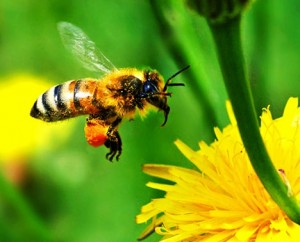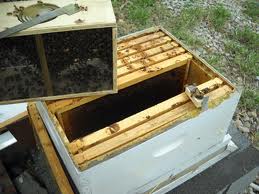 Packages are sold in units that contain from one to five pounds of bees, where there are about four thousand bees in a pound. For a beginner, a three-pound package with a queen is a good starting point. Packages are shipped by mail or rail freight and are usually two to three days in transit and if the supplier knows what they are doing they will not suffer from their journey.
Packages are sold in units that contain from one to five pounds of bees, where there are about four thousand bees in a pound. For a beginner, a three-pound package with a queen is a good starting point. Packages are shipped by mail or rail freight and are usually two to three days in transit and if the supplier knows what they are doing they will not suffer from their journey.
The package contains a small can of sugar syrup the bees use as feed. The queen is held separately in a queen cage within the package and this contains sugar candy on which the five or six worker bees in attendance in the queen cage may feed and feed the queen.
You must ensure that you have the bees new hive ready for them on delivery, as the bees should be placed in their new hive on the day they arrive, certainly no longer than 48 hours after arrival. As soon as the package of bees is delivered, you should spray the wire surface with a 1:1 mixture of sugar water, you can use a plant sprayer for this as long as it is
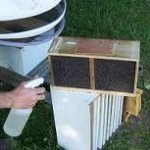 new or never had anything but water in it before. Alternatively you can paint the solution onto the wire, but spraying with a fine mist is the quickest way to ensure that the bees get a quick pick me up after their long journey. Usually a three pound package of bees will consume a pint or more of feed which should be given to them in four or five doses over a period of an hour or more. The bees in the package will be much more docile and easy to handle when placed in a hive if they are well fed. The package should be placed in a darkened room with an ideal temperature of 70 degrees Fahrenheit to settle them until you organise their new home.
new or never had anything but water in it before. Alternatively you can paint the solution onto the wire, but spraying with a fine mist is the quickest way to ensure that the bees get a quick pick me up after their long journey. Usually a three pound package of bees will consume a pint or more of feed which should be given to them in four or five doses over a period of an hour or more. The bees in the package will be much more docile and easy to handle when placed in a hive if they are well fed. The package should be placed in a darkened room with an ideal temperature of 70 degrees Fahrenheit to settle them until you organise their new home.
The bees in the package should be placed into the new hive in the late afternoon, ideally about half an hour to an hour before dusk. The reason for this is that in a strange location the bees that take wing without orientation can become lost or drift to another hive. If more than one package is being installed at the same time, the hives should be several feet apart and ideally the front entrances facing in different directions. In the event of cool or rainy weather it is better to go ahead with the installation of the package than it is to delay the matter. It is most important that the bees recognise the queen and begin brood rearing as soon as possible so that there are replacements for the old and dead bees in the pipe
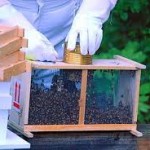 line.
line.
Package bees should be put on frames with new foundation, not old comb. In this way, if the package bees are carrying any honey with disease spores, the honey will be used in the construction of new wax and the disease spores will be lost. If package bees are installed on old combs, there is always the possibility of the bees’ depositing any honey they carry in the cells; such honey, if it contains disease spores, can later infect the colony. Obviously, installing package bees on foundation delays the development of the colony; brood rearing starts sooner if the queen has old combs in which to lay eggs. For this reason many beekeepers install their packages on old combs, watch the developing packages for disease and hope they did not buy bees infected with American foulbrood. We would suggest using new foundation but spray it well with your sugar mix to help the bees get started.
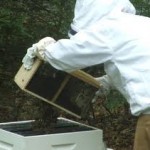
Installing the Package of Bees
Once you have your hive ready with your hive body open, remove a few frames or push them back if you do not have a full set in place to leave a space to easier tip the bees into. The actual steps in the installation of a package are as follows: feed the package, remove the wooden cover over the feeder can and remove the feeder can, shaking any bees that cling to it into the ready hive.
Now carefully remove the queen cage and make certain that the queen is alive, carefully pierce a hole part way through
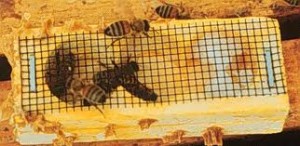 the candy to help the bees get started. The bees will release the queen from her cage usually within twelve hours by eating through to her. It is essential that they do not do this too quickly as it needs a few hours for them to gradually become used to her. Placed the queen cage candy end up between two frames so that the screen face of the cage is exposed to the bees, i.e facing into the middle of the two frames. Now shake the remaining bees from the package into the hive. It may be difficult to shake the last hundred or two hundred bees from the package. If the empty package is placed in front of the hive with the hole in the cage facing the hive, the bees will crawl into the hive if the weather is not too cold.
the candy to help the bees get started. The bees will release the queen from her cage usually within twelve hours by eating through to her. It is essential that they do not do this too quickly as it needs a few hours for them to gradually become used to her. Placed the queen cage candy end up between two frames so that the screen face of the cage is exposed to the bees, i.e facing into the middle of the two frames. Now shake the remaining bees from the package into the hive. It may be difficult to shake the last hundred or two hundred bees from the package. If the empty package is placed in front of the hive with the hole in the cage facing the hive, the bees will crawl into the hive if the weather is not too cold.
You should be wearing your bee suit and veil but you will not need any smoke if you have fed the bees as we suggested. As the package of bees, should be well fed and well-fed bees are gentle bees and should cause no difficulty.
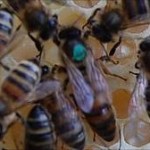
After the bees have been shaken into their home, one or preferably two feeders of sugar syrup should be placed on top of the frames, this can rest on the crown board and inside an empty super placed on top of the new hive. A newly installed three-pound package of bees will consume two ten-pound feeders of sugar syrup within a week or ten days and should be fed again when the containers are emptied the first time. Whether or not a third feeding is required depends upon how much natural nectar is available. In some areas packages may need a third feeding and may consume twenty to thirty pounds of sugar in total.
The entrance of the colony should be reduced to an opening of three-eighths by three inches. The colony should not beinspected for at least ten days, although the feeders should be checked after five to seven days. The purpose of the first inspection of a package of bees is merely to determine if the queen is alive and laying. If on inspection the queen is not present and laying, the only alternative is to combine the package with another package or colony. To make identification of the queen easier you should ask your bee package supplier for a marked queen. That is, she will have a coloured dot on her thorax.
More Information on Acquiring and Settling in New Bees
